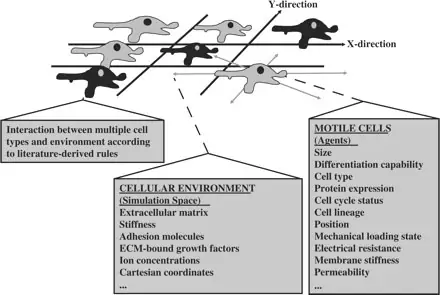(An Example of ABM in Agriculture Pest Control Studies. Source: University of Surrey)
An agent-based model (ABM) analyzes the impact of an individual on a system, and vice-versa.
The ‘individual’ could be a human being, an animal, a group of people, or even cells. In ABM, we set the behaviors of individual agents and see how the system interacts with those agents.
The main idea is to see how ‘micro-level’ factors impact ‘macro-level’ environments. It enables us to better understand the underlying realities of those environments and, in turn, see how we can shape those environments to act in favorable ways. Alternatively, we can also use ABM to acquire potential insights about the future — i.e., prevent negative outcomes.
In this post, we look at 4 notable agent-based modeling examples:
Notable Agent Based Modeling Examples
1. Analyzing the Spread of Epidemics
ABM can play a critical role in understanding the spread of communicable diseases, such as influenza, measles, and others.
In such studies, you could build a simulated model of the host area’s environment. As an example, you could have a city with an extensive public transportation network as well as the saturated central business area (e.g., downtown).
Next, you would set rules for the agents, such as how frequently they take the trains and buses, the fact that they go to a food court for lunch, and other common interactions.
The simulation will show you how fast — and extensively — the disease in question would spread. It could also show you where most infections could occur, or alternatively, are at a high-risk of occurring and under what conditions.
2. Understanding the Human Body
In recent years, agent-based modelling and simulation has made in-roads in biomedical research, notably in terms of the study of cells and molecules.
For example, biomedical researchers use ABM to study how tissue patterns develop as a result of cellular interactions. These researchers then use these insights to understand the growth of tumors, bone tissue regeneration, and other processes.
 Source: Briefings in Bioinformatics
Source: Briefings in Bioinformatics
Thus, ABM is living up to its potential of informing studies about complex cellular activity related to cancer, embryonic development, immunology, and other fields.
However, for ABM to work in this environment, researchers must still use lab testing as a means to validate their empirical rules (i.e., the rules they assign to each individual agent, such as cells). Otherwise, researchers will acquire the rules from literature outlining past — and verified — lab tests. To build accurate insights, the rules must be grounded in reality.
Leverage Simulation Modeling to
Lower Operating Costs
3. Studying Consumer Behavior
The study of consumer behavior is a common use-case of ABM.
One application of consumer studies (via ABM) is to identify the psychological triggers that compel consumers to select a particular brand over that brand’s competition. Researchers may use decoy effects and multi-agent systems (MAS) in these studies as well.
When defining rules for the consumer (i.e., the agent), researchers could draw on existing data about how past customers sought products/services. For example, the time they had spent in the store, the length of time they spent viewing a web page, etc.
You can also use survey data through questions asking consumers which option they would pick based on brand, distance, build quality, and other factors. For example, your survey can ask if the consumer would pick a 3-star restaurant that is a 5-minute drive over a 5-star hotel that is a 30-minute drive (or vice-versa).
4. Improving Supply Chains
A major challenge with studying supply chains is that supply chains contain many different interactions and, more importantly, that the interactions are unpredictable.
ABM is an effective way of studying complex systems such as supply chains because it can account for a large number of different actors and variables. You can use ABM to determine risk in your supply chain, identify opportunities to improve performance, and test solutions.
As long as you have the computing power, you can run supply chain ABM tests for cases as diverse as consumer-facing businesses to the U.S. Air Force’s fighter logistics network.
More on How to Get Business Insights using Simulation Modeling Engineering:
- 7 Key Advantages of Simulation for Business
- Better Staffing Through Simulation
- Advice on Outsourcing Simulation Modeling
Overall, a challenge with employing agent-based modeling is your ability to compute all of the necessary variables of your study. The more variables you insert, the more you will need; at a certain point, standard desktops and workstations will not be enough.
Secondly, you also need expertise to take-lead in developing the study, and that is typically no available in-house. However, you shouldn’t let the lack of expertise (or hardware) stop you from employing ABM, you can partner with an outside consulting firm to provide both.
MOSIMTEC designs and implements agent-based modeling studies for identifying risks and finding opportunities for cost-savings. Build a competitive edge by contacting us today!